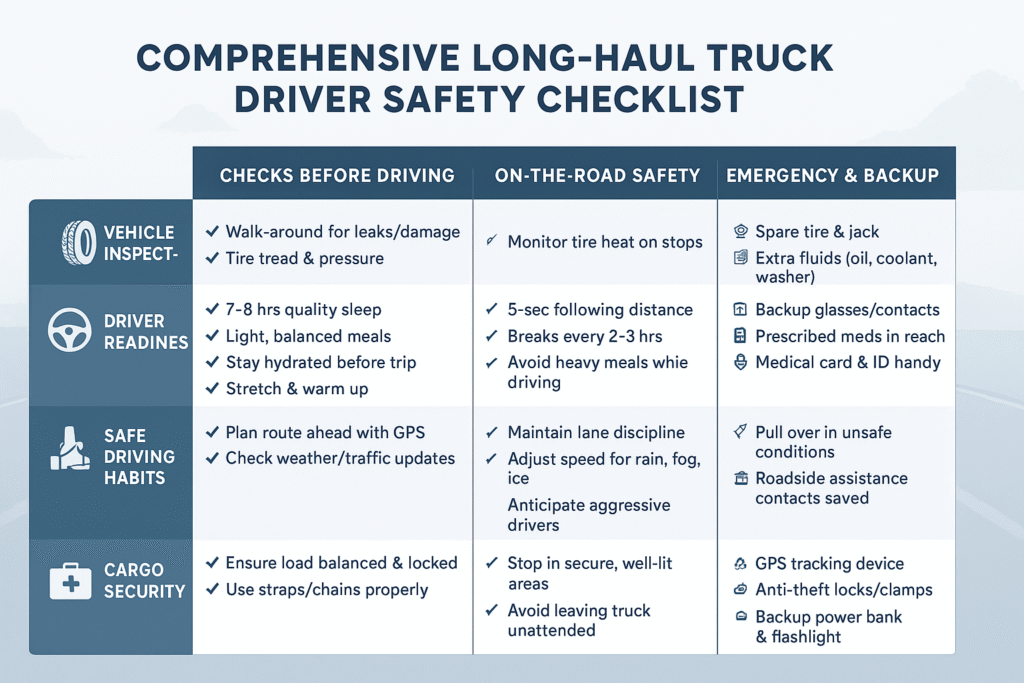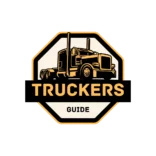Long-haul trucking is the backbone of America’s economy. Truck drivers deliver essential goods across thousands of miles daily, ensuring that businesses and families have what they need. But while the job offers freedom and good pay, it also carries real risks. According to the Federal Motor Carrier Safety Administration (FMCSA, 2024), nearly 13% of all large-truck crashes are linked to driver fatigue.
That’s why safety isn’t just a guideline—it’s survival. Whether you’re driving through the best states for truckers USA offers or navigating challenging terrains, adopting safety-first habits can save lives, protect cargo, and secure your career.
In this article, you’ll learn seven proven safety tips for long-haul truck drivers, backed by real-world examples and expert insights.
Why Safety is the Heart of Long-Haul Trucking
Safety isn’t just about compliance with regulations—it’s about responsibility. Every trip involves lives (yours and others on the road), valuable loads, and livelihoods that depend on your success.
Quick Fact: A single accident involving a semi-truck can cost $91,000+ in damages on average (American Transportation Research Institute, 2024).
By prioritizing safety, you protect yourself and the trucking industry’s reputation and America’s supply chain.
Understanding the Unique Risks of Long-Haul Trucking
Fatigue, Stress, and the Mental Strain of Endless Highways
Driving for 10–14 hours can cause fatigue, dulling reaction time, and judgment. Stress from tight deadlines exacerbates the situation, increasing the risk of accidents.
Weather, Terrain, and Unpredictable Road Conditions
Snow, fog, heavy rain, and steep mountain passes make trucking unpredictable. Drivers must adapt instantly or risk losing control.
The Pressure of Deadlines and Its Hidden Dangers
Company deadlines can tempt drivers to skip rest breaks. But pushing beyond safe limits often leads to accidents, costly delays, or worse—lives lost.
Mastering the Art of Pre-Trip Inspections
The Power of a Thorough Walk-Around Before Every Journey
A 15-minute pre-trip inspection can prevent disasters. Look for visible issues, leaks, or wear before hitting the road.
Checking Tires, Brakes, and Lights: The Trio That Saves Lives
- Tires: Ensure proper pressure and tread depth.
- Brakes: Test air brakes and emergency systems.
- Lights: Verify headlights, indicators, and brake lights work.
Why Fluids and Leaks Can Make or Break Your Safety
Check oil, coolant, and windshield washer fluid. A simple leak can escalate into breakdowns or engine failure on the road.
Staying Alert and Fighting Driver Fatigue
The Science of Sleep: Why Rest Matters More Than Caffeine
No amount of coffee can replace quality rest. Drivers need 7–9 hours of real sleep for optimal alertness.
Recognizing the Red Flags of Drowsy Driving
- Frequent yawning
- Blurry vision
- Difficulty focusing
- Drifting out of lanes
Strategic Rest Stops and Power Naps for Safer Roads
Schedule breaks every 2–3 hours and take 20-minute power naps when needed.
Smart Nutrition and Hydration on the Road
How Balanced Meals Keep Reflexes Sharp
Eating protein-rich foods and fresh fruits boosts energy and concentration.
The Hidden Risks of Energy Drinks and Junk Food
Energy drinks may give a quick boost but cause crashes in energy levels, increasing fatigue.
Water: The Underrated Safety Tool for Truckers
Dehydration leads to headaches and slower reflexes. Keep a gallon of water handy for long trips.
Defensive Driving as a Lifesaving Habit
The 5-Second Rule for Safe Following Distance
Maintain at least 5 seconds of distance from vehicles ahead to allow safe braking.
Predicting the Moves of Aggressive Drivers Around You
Watch for sudden lane changes, speeding cars, or tailgaters. Anticipating risky behavior prevents collisions.
How to Stay Calm in High-Traffic Pressure Zones
Patience and lane discipline reduce stress and accidents in crowded city routes.
Weather-Proofing Your Driving Strategy
Navigating Rain, Fog, and Ice Without Panic
- Reduce speed
- Use low beams in fog.
- Avoid sudden braking on ice.
Essential Tools Every Truck Should Carry for Emergencies
- Tire chains
- Flares and reflective triangles
- Heavy blankets
- Extra food and water
Knowing When to Pull Over Instead of Pushing Through
If conditions are unsafe, parking safely is better than risking your life.
Technology and Safety: A Driver’s Best Allies
How GPS and Dashcams Can Enhance Safety Awareness
GPS prevents missed turns and unsafe detours, while dashcams provide legal protection in accidents.
The Role of Telematics in Preventing Accidents
Telematics tracks driving habits like harsh braking or speeding, helping drivers improve safety.
Why Regular Communication with Dispatch Boosts Security
Staying in touch ensures help is available in emergencies or route changes.
Emergency Preparedness on the Open Road
Building a Reliable Roadside Emergency Kit
Your kit should include:
- First aid supplies
- Flashlight with extra batteries
- Reflective vest
- Fire extinguisher
What to Do in Case of Breakdowns or Collisions
- Pull over safely
- Place reflective triangles
- Contact dispatch and emergency services
Steps to Protect Yourself in Remote or Isolated Areas
Keep your phone charged, carry maps, and avoid stopping in poorly lit areas.
Mental Health and Stress Management for Truckers
How Loneliness Can Impact Decision-Making on the Road
Isolation often leads to stress, depression, and poor focus.
Simple Practices to Stay Mentally Strong on Long Routes
- Stretching at rest stops
- Journaling thoughts
- Setting realistic driving goals
The Role of Music, Podcasts, and Calls in Staying Connected
Engaging audio content and regular calls with loved ones combat loneliness.
Protecting Cargo While Staying Safe
Secure Loads, Secure Journeys: The Basics of Cargo Safety
Always double-check straps, locks, and seals before departure.
How to Avoid Theft and Cargo Tampering on Stops
- Park in well-lit, secure areas
- Use trailer locks
- Avoid leaving loads unattended.
The Legal and Financial Risks of Improper Load Securement
Improperly secured cargo can cause accidents and lead to fines or license suspension.
The Importance of Continuous Training and Education
Why Safety Certifications Are Worth Your Time
Certifications keep you updated on industry standards and improve job opportunities.
Staying Updated with Changing Laws and Road Regulations
Each state may have unique trucking laws—ignorance is not an excuse in court.
Peer Learning: Gaining Wisdom from Experienced Drivers
Talking with veteran truckers can provide practical tips books can’t teach.

Frequently Asked Questions (FAQs) for Long-Haul Truck Drivers
What are the top safety tips for long-haul truck drivers?
The most important safety tips include proper pre-trip inspections, managing fatigue with enough rest, eating balanced meals, defensive driving, adapting to weather conditions, using technology wisely, and staying mentally healthy. Following these steps reduces accident risks and improves road confidence.
How many hours can a truck driver legally drive in the U.S.?
According to the FMCSA Hours of Service (HOS) rules, long-haul truck drivers can drive 11 hours after 10 consecutive hours off duty. Drivers cannot drive beyond 14 consecutive hours after coming on duty. Weekly limits apply, usually 60/70 hours in 7/8 days.
What are the top safety tips for long-haul truck drivers?
The most important safety tips include proper pre-trip inspections, managing fatigue with enough rest, eating balanced meals, defensive driving, adapting to weather conditions, using technology wisely, and staying mentally healthy. Following these steps reduces accident risks and improves road confidence.
How many hours can a truck driver legally drive in the U.S.?
According to the FMCSA Hours of Service (HOS) rules, long-haul truck drivers can drive 11 hours after 10 consecutive hours off duty. Drivers cannot drive beyond 14 consecutive hours after coming on duty. Weekly limits apply, usually 60/70 hours in 7/8 days
What causes most truck accidents in the U.S.?
The leading causes include driver fatigue, speeding, distracted driving, poor cargo securement, and unsafe road/weather conditions. Fatigue alone contributes to nearly 13% of large-truck crashes. Staying alert, rested, and cautious helps prevent most of these accidents.
How can truck drivers fight fatigue on long trips?
Truckers should get 7–9 hours of sleep, take regular breaks every 2–3 hours, avoid heavy junk food, stay hydrated, and use short power naps when needed. Relying on caffeine or energy drinks alone is risky—they provide only temporary alertness.
What should a truck driver include in an emergency kit?
An emergency kit should have:
1- First aid supplies
2- Flashlight and spare batteries
3- Reflective triangles or flares
4- Extra blankets, food, and water
5- Fire extinguisher
6- Tire chains and basic repair tools
These items are lifesavers in breakdowns or severe weather.
How can truck drivers drive safely in rain, snow, or fog?
Reduce speed, keep headlights on low beam, increase following distance, and avoid sudden braking. Use tire chains when required in snow or ice and pull over if visibility or traction becomes unsafe. Safety always outweighs deadlines.
What are the legal consequences of not securing cargo properly?
Improper cargo securement can lead to hefty fines, CSA score penalties, and even license suspension. Worse, it may cause rollovers or road accidents, making the driver liable for damages and injuries. Always double-check straps, locks, and seals.
Do truck drivers need continuous training?
Yes. Safety certifications, CDL refresher courses, and training in new technology help drivers stay compliant with FMCSA rules and improve job opportunities. Many companies also reward trained drivers with better routes and higher pay.
What are the best healthy snacks for truck drivers on the road?
Great choices include nuts, protein bars, boiled eggs, fruit, yogurt, and lean jerky. Avoid energy drinks, soda, and greasy fast food since they cause energy crashes and slow reflexes. Balanced nutrition sharpens focus and reduces fatigue.
How can truck drivers protect themselves from cargo theft?
Park only in well-lit and secure truck stops, use trailer locks, avoid leaving loads unattended, and maintain constant communication with dispatch. Some drivers also use GPS-tracked locks for extra security.
How can truckers reduce stress and loneliness on long hauls?
Truckers can listen to music, audiobooks, or podcasts, schedule regular calls with family, and practice stretching or light exercise during stops. Simple mental health practices like journaling or setting small goals also reduce stress.
What should a trucker do after an accident or breakdown?
First, pull over safely and turn on hazard lights. Place reflective triangles, contact dispatch and emergency services, and document the scene if possible. Staying calm and prepared ensures safety until help arrives.
Are technologies like dashcams and telematics worth it for truckers?
Absolutely. Dashcams protect drivers legally by recording accidents, while telematics systems monitor driving habits, fuel use, and route efficiency. GPS navigation also prevents unsafe detours and saves time.
How much water should truck drivers drink daily?
Aiming for at least half a gallon to a gallon (2–4 liters) daily helps prevent dehydration, headaches, and fatigue. Dehydration can slow reflexes, making it a hidden safety risk for truckers.
Do trucking regulations vary by state?
Yes. While FMCSA sets federal rules, each state may have additional regulations such as speed limits, rest area availability, and winter chain laws. Drivers should always check state-specific laws before entering new routes.
Conclusion: Driving Safe, Driving Smart
Long-haul trucking is more than just a job—it’s a responsibility that keeps America’s economy moving. Truck drivers can protect themselves, their cargo, and everyone on the road by mastering pre-trip inspections, managing fatigue, eating smart, practicing defensive driving, preparing for weather, and embracing technology.
Every mile you drive carries both opportunity and risk. The difference lies in how prepared you are. Safety isn’t just about following FMCSA rules—it’s about protecting your livelihood, health, and future.
Next steps for truckers:
- Commit to making safety a daily habit.
- Keep learning and stay updated on regulations.
- Invest in tools, training, and practices that make you a more competent driver.
👉 For more trucking tips, industry updates, and the latest news on U.S. trucking regulations, visit TruckersGuide.us — your trusted resource for life on the open road.


